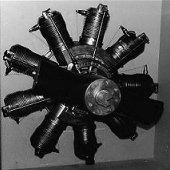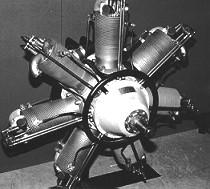Aircraft Engines
Pistons in cylinders first saw use in
steam engines. Scotland's James Watt crafted the first good ones during
the 1770s. A century later, the German inventors Nicolaus Otto and
Gottlieb Daimler introduced gasoline as the fuel, burned directly within
the cylinders. Such motors powered the earliest automobiles. They were
lighter and more mobile than steam engines, more reliable, and easier to
start.
Some single-piston gasoline engines
entered service, but for use with airplanes, most such engines had a
number of pistons, each shuttling back and forth within its own cylinder.
Each piston also had a connecting rod, which pushed on a crank that was
part of a crankshaft. This crankshaft drove the propeller.
The cylinder is closed on one end (the
cylinder head), and the piston fits snugly in the cylinder. The piston
wall is grooved to accommodate rings which fit tightly against the
cylinder wall and help seal the cylinder's open end so that gases cannot
escape from the combustion chamber. The combustion chamber is the area
between the top of the piston and the head of the cylinder when the piston
is at its uppermost point of travel.
The up-and-down movement
of the piston is converted to rotary motion to turn the propeller by the
connecting rod and the crankshaft, just as in most automobiles. Note the
crankshaft, connecting rod, and piston arrangement and
imagine how the movement of the piston is converted to the rotary motion
of the crankshaft. Note particularly how the connecting rod is joined to
the crankshaft in an offset manner.
The valves at
the top of the cylinder open and close to let in a mixture of fuel and air
and to let out, or exhaust, burned gases from the combustion chamber. The
opening and closing of a valve are done by a cam geared to the crankshaft.
This gearing arrangement ensures that the two valves open and close at the
proper times.
Engines built for airplanes had to
produce plenty of power while remaining light in weight. The first
American planebuilders—Wilbur and Orville Wright, Glenn Curtiss—used
motors that resembled those of automobiles. They were heavy and complex
because they used water-filled plumbing to stay cool.

Gnome rotary
A French engine of 1908, the "Gnome,"
introduced air cooling as a way to eliminate the plumbing and lighten the
weight. It was known as a rotary engine. The Wright and Curtiss motors had
been mounted firmly in supports, with the shaft and propeller spinning.
Rotary engines reversed that, with the shaft being held tightly—and the
engine spinning! The propeller was mounted to the rotating engine, which
stayed cool by having its cylinders whirl within the open air.
During World War I, rotaries attained
tremendous popularity. They were less complex and easier to make than the
water-cooled type. They powered such outstanding fighter planes as
German's Fokker DR-1 and Britain's Sopwith Camel. They used castor oil for
lubrication because it did not dissolve in gasoline. However, they tended
to spray this oil all over, making a smelly mess. Worse, they were limited
in power. The best of them reached 260 to 280 horsepower (190 to 210
kilowatts).
Thus, in 1917 a group of American engine
builders returned to water cooling as they sought a 400-horsepower
(300-kilowatt) engine. The engine that resulted, the Liberty was the most
powerful aircraft engine of its day, with the U.S. auto industry building
more than 20,000 of them. Water-cooled engines built in Europe also
outperformed the air-cooled rotaries, and lasted longer. With the war
continuing until late in 1918, the rotaries lost favour.

Liberty engine
In this fashion, designers returned to
water-cooled motors that again were fixed in position. They stayed cool by
having water or antifreeze flow in channels through the engine to carry
away the heat. A radiator cooled the heated water. In addition to offering
plenty of power, such motors could be completely enclosed within a
streamlined housing, to reduce drag and thus produce higher speeds in
flight. Rolls Royce, Great Britain's leading engine-builder, built only
water-cooled motors.

